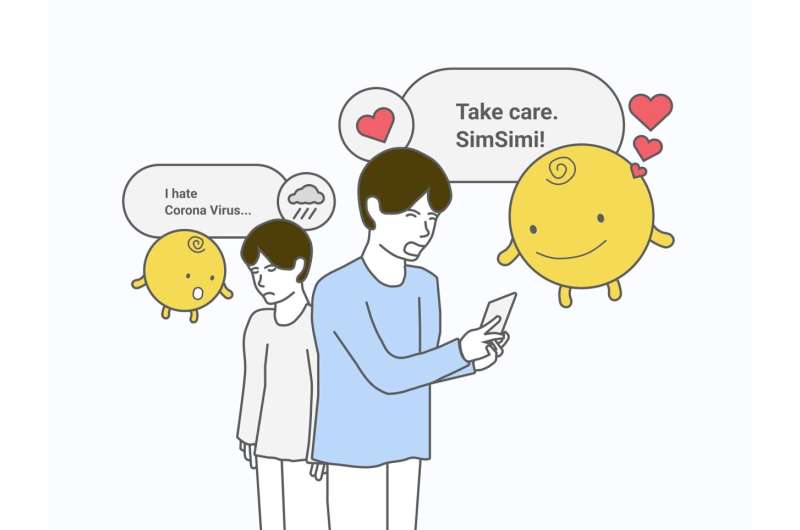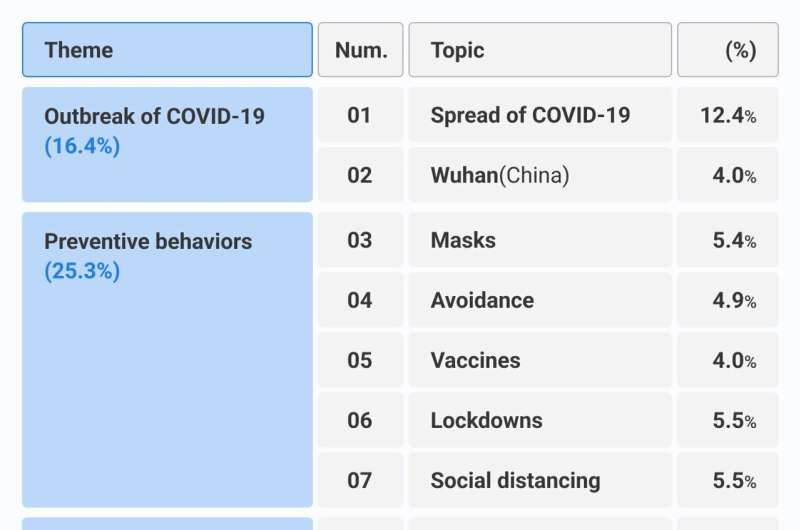During the Covid-19 pandemic, users sought health-related information and shared emotional messages with the chatbot, indicating the potential use of chatbots to provide accurate health information and emotional support. Credit: Institute for Basic Science
The COVID-19 pandemic has increased people's reliance on digital platforms, such as social media, to obtain information and communicate their thoughts and emotions with their peers. The sudden shift from offline to online interactions due to the COVID-19 pandemic has fueled the popularity of chatbots in many fields, including the medical domain. The World Health Organization (WHO) has even used a chatbot to fight against false information, and they are still looking into how this new technology can help them prepare for future pandemics.
A new study has shown the potential of AI chatbots to relieve users' anxiety and quickly deliver information during major social upheavals. Led by Chief Investigator Cha Meeyoung of the Data Science Group within the Institute for Basic Science (IBS) and Dr. Cha Chiyoung from Ewha Woman's University's College of Nursing, the researchers analyzed nearly 20,000 conversations between online users and a chatbot called SimSimi.
This commercial chatbot has served over 400 million users worldwide in 81 languages. The joint research team investigated how users from the United States, United Kingdom, Canada, Malaysia, and the Philippines used the chatbot during the COVID-19 pandemic.
This study is one of the first to analyze large-scale data on conversations related to COVID-19 between chatbots and humans.
Dr. Chin Hyojin, the lead author of the study said, "Chatbots are a promising tool to fulfill people's informational needs in challenging times. While health institutions such as the Korea Center for Disease Control and Prevention and the World Health Organization (WHO) have used chatbots to provide the most up-to-date information on the spread and symptoms of COVID-19 to billions of people, it was unclear how users interacted with such systems in times of crisis."
The average percentage of positive and negative-related words in COVID-19–related conversations by country according to the Linguistic Inquiry and Word Count dictionary. Credit: Institute for Basic Science
The researchers employed natural language processing (NLP) techniques to identify a series of topics discussed by online users when talking to the chatbot. The results show that users use the chatbot to ask questions about the disease and have a small talk during periods of social isolation due to the pandemic.
During the pandemic's lockdowns, the chatbot frequently served as a conversation companion for obtaining information and expressing emotions. The researchers found 18 COVID-19-related topics that people conversed with the chatbot using topic modeling, a machine learning technique that discovers conversation topics from large-scale text data, and classified them into overarching themes.
Some of these themes included the outbreak of COVID-19, preventative behaviors, the physical and psychological impact of COVID-19, people and life in the pandemic, and questions about COVID-19. This showed that many users sought information and queried the chatbot about the pandemic, even though the particular chatbot under study was not designed to deliver specific information on COVID-19.
Topics discussed by users with the chatbot identified by the Latent Dirichlet Allocation topic model and their prevalence. Credit: Institute for Basic Science
In terms of how people felt, the team employed computational tools to compare how each of these themes made them feel. Although some topics, such as masks, lockdowns, and disease dread elicited negative emotions, it was discovered that daily chatter with the chatbot mostly led to positive emotions. There were also regional differences based on geographics. For example, U.S.-based users were found to more frequently use negative keywords in comparison to users from Asia.
Chief Investigator Cha said, "This study is unique because it is the first to use commercial chatbot conversations that are not dedicated to mental support during the pandemic. Because individuals are sharing their concerns and seeking assistance from social chatbots, they can be an essential tool for health care during crises like the COVID-19 pandemic. The next stage is understanding individuals' intentions and utilizing the knowledge to create systems that better respond to user demands during difficult times."
The study was published in the Journal of Medical Internet Research (JMIR) as part of a series called "Chatbots and COVID-19," which was organized by the WHO.
More information: Hyojin Chin et al, User-Chatbot Conversations During the COVID-19 Pandemic: A Study Based on Topic Modeling and Sentiment Analysis (Preprint), Journal of Medical Internet Research (2023). DOI: 10.2196/40922
Journal information: Journal of Medical Internet Research
Provided by Institute for Basic Science

























